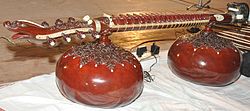
Back রুদ্রবীণা Bengali/Bangla Rudra vina Catalan Rudra vina Spanish ರುದ್ರ ವೀಣೆ Kannada രുദ്രവീണ Malayalam रुद्र वीणा Marathi ਰੁਦਰ ਵੀਨਾ Punjabi Rudra vina Polish Rudra vina Swedish உருத்ர வீணை Tamil
This article needs additional citations for verification. (April 2021) |
 Rudra veena | |
| String instrument | |
|---|---|
| Other names | Rudra vīnā, Been, Bin |
| Classification | String instrument |
| Hornbostel–Sachs classification | 311.222 (True stick zither: instruments in which sound is produced by one or more vibrating strings, which consist solely of a string bearer or a string bearer with a resonator that is not integral to the instrument, with a string bearer shaped like a bar (bar zither), has a rigid and inflexible string carrier (stick zither), has no curved or flexible end (true stick zither), has more than one resonator gourds.) |
| Developed | By late 15th century |
| Musicians | |
| Asit Kumar Banerjee, Anant Bedekar, Bahauddin Dagar (b. 1970), Zia Mohiuddin Dagar (1929–1990), Mohammed Khan Faridi, Ustad Shamsuddin Faridi Desai (1936–2011), Zahid Faridi Desai, Hindraj Divekar (1954–2019), Jyoti Hegde, R.V. Hegde (b. 1953), Ustad Abid Hussain Khan, Ustad Asad Ali Khan (1937–2011), Bande Ali Khan (1826–1890), Jamaluddin Khan, Murad Khan, Naubat Khan, Omrao Khan, Rajab Ali Khan, Wazir Khan (Rampur), Zahid Khan, Krishnarao Kholapure, Sharada Mushti, Madhuvanti Pal (b. 1992), Dattatreya Rama Rao Parvatikar (1916–1990), Bindu Madhav Pathak (1935–2004), Shrikant Pathak, Peter Row (1944–2018), P.D. Shah (1911–1975), Carsten Wicke (b. 1970) | |
| Builders | |
| Kanailal & Brother, Kolkata | |
| More articles or information | |
| Veena, Saraswati veena, Vichitra veena, Chitra veena, Pinaka vina, Ālāpiṇī vīṇā | |
The Rudra veena (Sanskrit: रुद्र वीणा) (also spelled Rudraveena[1] or Rudra vīnā[2])—also called Bīn in North India[3]—is a large plucked string instrument used in Hindustani Music, especially dhrupad.[2] It is one of the major types of veena played in Indian classical music, notable for its deep bass resonance.[4]
The rudra veena is seen in temple architecture predating the Mughals. It is also mentioned in court records as early as the reign of Zain-ul Abidin (1418–1470),[3] and attained particular importance among Mughal court musicians.[3] Before Independence, rudra veena players, as dhrupad practitioners, were supported by the princely states; after Independence and the political integration of India, this traditional patronage system ended.[5] With the end of this traditional support, dhrupad's popularity in India declined, as did the popularity of the rudra veena.[5] However, in recent years, the rudra veena has seen a resurgence in popularity, driven at least partly by interest among non-Indian practitioners.[5][6]
- ^ Peddi, Sowjanya (26 November 2015). "Mastering the king of instruments". Thehindu.com. Retrieved 1 December 2021.
- ^ a b "Stick Zither with Gourd Resonators (Rudra Vina or Bin), Northern India, at the National Music Museum". Collections.nmmusd.org. Retrieved 1 December 2021.
- ^ a b c Dick, Alastair; Widdess, Richard; Bruguière, Philippe; Geekie, Gordon (29 October 2019), "Vīṇā", Grove Music Online, doi:10.1093/omo/9781561592630.013.90000347354, ISBN 9781561592630, retrieved 13 July 2021
{{citation}}: Missing or empty|title=(help) - ^ "The Tribune, Chandigarh, India - Arts Tribune". Tribuneindia.com. Retrieved 1 December 2021.
- ^ a b c "Ustad Bahauddin Dagar interview: 'Dhrupad - flourishing branches, dwindling roots?'". Darbar.org. Retrieved 1 December 2021.
- ^ "What is the future of ancient rudra veena in Hindustani classical?". 17 October 2017.
© MMXXIII Rich X Search. We shall prevail. All rights reserved. Rich X Search